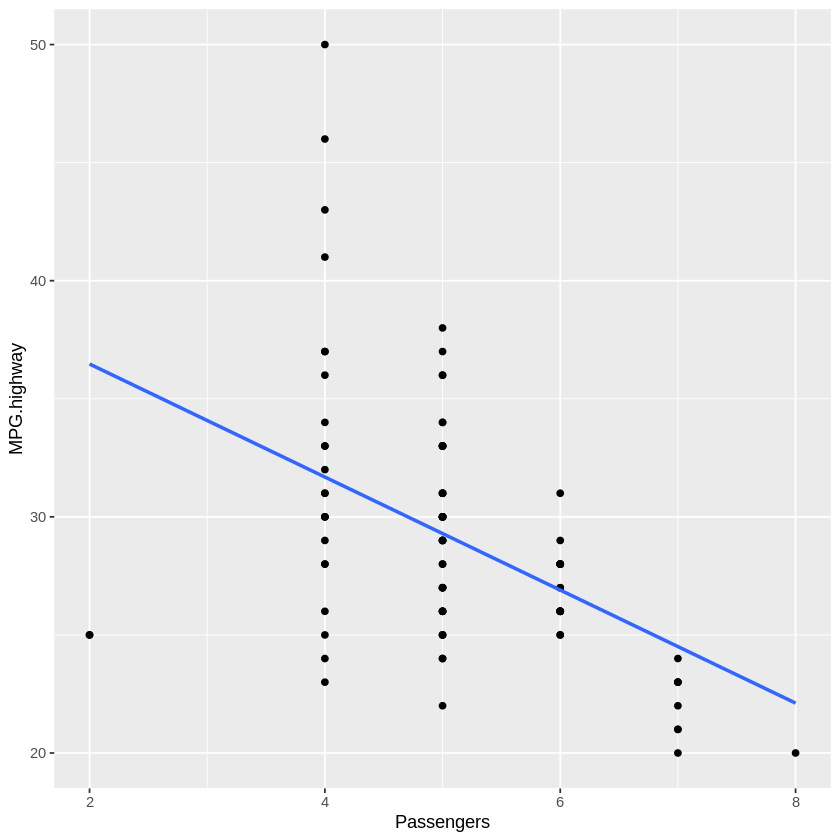Tutorial: Running mediation and moderation models#
This lab focuses on mediation and moderation and implementing these techniques in R.
Goals:#
Understand the difference between moderation and mediation.
Learn how to detect mediation effects using the
mediatefunction.Learn how to detect moderating effects.
This tutorial draws from Chapter 14: Mediation and Moderation in a collection of tutorials by psychology grad students at the University of Illinois at Chicago.
The difference between mediation and moderation#
First, let’s reiterate the difference between mediation and moderation.
For an independent variable \(X\), a dependent variable \(Y\) and a third variable \(M_e\), mediation is when the value of \(X\) impacts the value of \(M_e\), which in turn predicts the value of \(Y\). Put differently, if \(X\) operates on \(Y\) through \(M_e\), then \(M_e\) is a mediating variable: \(X \rightarrow M_e \rightarrow Y\)
A couple examples of mediation:
For Spanish language learners who move from the U.S. to Spain, time since they moved to Spain (\(X\)) predicts ability to speak Spanish (\(Y\)) because they get more practice speaking and comprehending Spanish (\(M_e\)) the more time they spend there. \(M_e\) is an important mediator to note, because if you spend a long time in Spain without speaking or listening to Spanish, your Spanish skills will not improve. In this example, practice mediates the effect of time on ability.
Maybe you’ve noticed that there are better discussions during lab meetings when you order pizza. This is probably because of the impact of pizza on both attendance and the mood of the attendees, and so both of these could be mediating variables between pizza and discussion quality.
In contrast, moderation describes how a third variable \(M_o\) impacts the relationship between \(X\) and \(Y\). Perhaps the relationship between \(X\) and \(Y\) is stronger when \(M_o\) is positive than when \(M_o\) is negative. Moderating variables basically contextualize the \(X \rightarrow Y\) relationship, instead of causing it like mediating variables do. Moderation is basically an interaction effect, where one of the independent variables is regarded as less important to the scientific question and is thus deemed a “moderator” instead of a “predictor”.
A couple examples of moderation:
The relationship between importance of a task (\(X\)) and testing anxiety (\(Y\)) is moderated by self-efficacy (\(M_o\)). Most students feel low anxiety for unimportant assignments, but those with low self-efficacy are more stressed during important exams than those with high self-efficacy. What’s key in this example is the interaction between self-efficacy and task importance: the relationship between task importance and anxiety varies for different levels of self efficacy, and the relationship between self efficacy and anxiety varies for different levels of task importance.
The relationship between time of year and a person’s Vitamin D deficiency is moderated by location - in Boston, Vitamin D deficiency might peak in February; in Punta Arenas, Chile it might peak in September; and in a place that’s mostly sunny year-round like Florida the relationship between time of year and deficiency might be weak or nonexistent. What would be a mediating variable between time of year and vitamin D deficiency?
Mediation in R#
Now let’s try finding evidence for mediation using R. We’ll use the Cars93 dataset we’ve used in previous tutorials.
install.packages("mediation") # uncomment to install the mediation package.
library(mediation)
library(MASS)
library(tidyverse)
names(Cars93)
# ?mediate # uncomment to learn about the mediate function
- 'Manufacturer'
- 'Model'
- 'Type'
- 'Min.Price'
- 'Price'
- 'Max.Price'
- 'MPG.city'
- 'MPG.highway'
- 'AirBags'
- 'DriveTrain'
- 'Cylinders'
- 'EngineSize'
- 'Horsepower'
- 'RPM'
- 'Rev.per.mile'
- 'Man.trans.avail'
- 'Fuel.tank.capacity'
- 'Passengers'
- 'Length'
- 'Wheelbase'
- 'Width'
- 'Turn.circle'
- 'Rear.seat.room'
- 'Luggage.room'
- 'Weight'
- 'Origin'
- 'Make'
The effect we’re interested in for this example is the relationship between Passengers (the max number of passengers the car model is designed to carry) and MPG.highway (the number of miles per gallon the car gets on the highway. Look at the model and visualization of this relationship below.
fitStart <- lm(MPG.highway ~ Passengers, data=Cars93)
summary(fitStart)
ggplot(Cars93,aes(x=Passengers,y=MPG.highway)) + geom_point() + geom_smooth(method="lm",se=FALSE)
Call:
lm(formula = MPG.highway ~ Passengers, data = Cars93)
Residuals:
Min 1Q Median 3Q Max
-11.4720 -2.2919 -0.5052 1.7081 18.3147
Coefficients:
Estimate Std. Error t value Pr(>|t|)
(Intercept) 41.2587 2.4697 16.71 < 2e-16 ***
Passengers -2.3934 0.4759 -5.03 2.46e-06 ***
---
Signif. codes: 0 ‘***’ 0.001 ‘**’ 0.01 ‘*’ 0.05 ‘.’ 0.1 ‘ ’ 1
Residual standard error: 4.742 on 91 degrees of freedom
Multiple R-squared: 0.2175, Adjusted R-squared: 0.2089
F-statistic: 25.3 on 1 and 91 DF, p-value: 2.456e-06
`geom_smooth()` using formula 'y ~ x'

While it is not clear what’s going on with that 2-person vehicle in the bottom left, generally we can see that more passengers means worse mileage on the highway. But let’s take a minute to think about why that is. Cars that can hold more passengers tend to be bigger. I’m not a car person, but it makes sense heavier cars and cars with more air resistance would need to use more gas to maintain the same speed as lighter, more compact cars. Let’s just focus on weight in this example: is Weight a mediating variable between Passengers and MPG.highway? In other words, is weight the causal link between these two variables?
The way we’ll answer this question is using the mediate function from the mediation package we installed above. The logic behind this analysis is as follows:
If there’s a relationship between \(X\) and \(M_e\)
And when you include both \(M_e\) and \(X\) in a model to predict \(Y\), the effect of \(X\) on \(Y\) goes away
Then the original effect of \(X\) on \(Y\) (which we showed above) must be mediated by \(M_e\).
The mediate function takes in models that capture steps 1 and 2 above, and outputs a conclusion regarding 3.
fitM <- lm(Weight ~ Passengers, data=Cars93) #Step 1: IV on M, Number of passengers predicting weight of car
fitY <- lm(MPG.highway ~ Weight + Passengers, data=Cars93) #Step 2: IV and M on DV, Number of passengers and weight predicting highway
summary(fitM)
summary(fitY)
fitMed <- mediate(fitM, fitY, treat="Passengers", mediator="Weight")
summary(fitMed)
Call:
lm(formula = Weight ~ Passengers, data = Cars93)
Residuals:
Min 1Q Median 3Q Max
-1036.75 -381.75 36.73 308.25 1276.51
Coefficients:
Estimate Std. Error t value Pr(>|t|)
(Intercept) 1475.23 257.31 5.733 1.27e-07 ***
Passengers 314.13 49.58 6.336 8.85e-09 ***
---
Signif. codes: 0 ‘***’ 0.001 ‘**’ 0.01 ‘*’ 0.05 ‘.’ 0.1 ‘ ’ 1
Residual standard error: 494.1 on 91 degrees of freedom
Multiple R-squared: 0.3061, Adjusted R-squared: 0.2985
F-statistic: 40.14 on 1 and 91 DF, p-value: 8.85e-09
Call:
lm(formula = MPG.highway ~ Weight + Passengers, data = Cars93)
Residuals:
Min 1Q Median 3Q Max
-7.7134 -1.8418 -0.0271 1.8858 11.5668
Coefficients:
Estimate Std. Error t value Pr(>|t|)
(Intercept) 51.8777927 1.9165318 27.069 <2e-16 ***
Weight -0.0071983 0.0006692 -10.756 <2e-16 ***
Passengers -0.1321634 0.3799662 -0.348 0.729
---
Signif. codes: 0 ‘***’ 0.001 ‘**’ 0.01 ‘*’ 0.05 ‘.’ 0.1 ‘ ’ 1
Residual standard error: 3.154 on 90 degrees of freedom
Multiple R-squared: 0.6576, Adjusted R-squared: 0.65
F-statistic: 86.44 on 2 and 90 DF, p-value: < 2.2e-16
Causal Mediation Analysis
Quasi-Bayesian Confidence Intervals
Estimate 95% CI Lower 95% CI Upper p-value
ACME -2.246 -3.058 -1.44 <2e-16 ***
ADE -0.135 -0.857 0.65 0.73
Total Effect -2.382 -3.371 -1.43 <2e-16 ***
Prop. Mediated 0.942 0.688 1.36 <2e-16 ***
---
Signif. codes: 0 ‘***’ 0.001 ‘**’ 0.01 ‘*’ 0.05 ‘.’ 0.1 ‘ ’ 1
Sample Size Used: 93
Simulations: 1000
The first model established that there was a significant relationship between Weight and Passengers. The second model established that when you include Weight in the model, Passengers is no longer a significant predictor of MPG.highway. The last one shows us that there is a strong mediating effect. ACME represents the mediating or indirect effect, which can be thought of as answering the question “Given this model, would I predict that \(Y\) would change significantly when I vary \(M_e\) but hold \(X\) constant?” ADE answers the opposite question, varying \(X\) while holding \(M_e\) constant (“direct effect”). The Total Effect combines the direct and indirect effects, and Prop. Mediated is the proportion of indirect effects relative to direct effects. The results above tell us that the relationship between Passengers and MPG.highway is entirely mediated by Weight.
Note: the ouput above says “Simulations: 1000” at the bottom. There is a bootstrapping feature for the mediate function, and the default settings are boot = FALSE and sims = 1000. Even though no bootstrapping was done in this example it still outputs the number of simulations it would have run, for some reason. If you’re interested, play around with the bootstrap functionality by setting boot = TRUE and see whether that impacts your results. Since this is a strong result, it probably won’t.
Moderation in R#
As discussed above, looking for moderation is basically the same as looking for an interaction. If the relationship between \(X\) and \(Y\) is moderated by \(M_o\), then the interaction between \(X\) amd \(M_o\) should be significant. We can look at this using the simple lm() function.
We’ll stick with the Cars93 data set, and see if the relationship between Weight and MPG.highway is moderated by Horsepower - in other words, do cars with more powerful engines show a different relationship between Weight and MPG.highway than cars with less powerful engines do?
fitMod <- lm(MPG.highway ~ Horsepower*Weight,data=Cars93)
summary(fitMod)
Call:
lm(formula = MPG.highway ~ Horsepower * Weight, data = Cars93)
Residuals:
Min 1Q Median 3Q Max
-7.6537 -1.9269 -0.2388 1.9899 11.6858
Coefficients:
Estimate Std. Error t value Pr(>|t|)
(Intercept) 6.551e+01 4.537e+00 14.440 < 2e-16 ***
Horsepower -1.347e-01 3.955e-02 -3.406 0.000991 ***
Weight -1.132e-02 1.493e-03 -7.585 3.06e-11 ***
Horsepower:Weight 3.822e-05 1.132e-05 3.377 0.001088 **
---
Signif. codes: 0 ‘***’ 0.001 ‘**’ 0.01 ‘*’ 0.05 ‘.’ 0.1 ‘ ’ 1
Residual standard error: 2.984 on 89 degrees of freedom
Multiple R-squared: 0.6969, Adjusted R-squared: 0.6867
F-statistic: 68.21 on 3 and 89 DF, p-value: < 2.2e-16
Since the Horsepower:Weight term is significant, there might be some moderation going on here! To understand the relationship better, let’s do a split-half visualization for cars with lower horsepower and cars with higher horsepower.
medH <- median(Cars93$Horsepower)
Cars93 %>%
# make a new variable for split half vis: is horsepower above or below median?
mutate(highHorsepower = factor(ifelse(Horsepower < medH,"Low","High"),levels=c("Low","High"))) %>% # "levels" just makes "low" appear on left
ggplot(.,aes(x = Weight,y = MPG.highway)) +
geom_point() + geom_smooth(method="lm",se=FALSE) + # add points and a fit line
facet_grid(.~highHorsepower)
This was a useful visualization. Now we know that the different relationship between weight and efficiency for powerful engines versus less powerful engines might be because cars with more horsepower are typically heavier. In other words, Horsepower and Weight are correlated, and we’ve violated one of the assumptions for using linear models - oops! So we can’t interpret the moderation in this case. Dealing with correlated predictor variables will be discussed later in this class.
Notebook authored by Patience Stevens and edited by Amy Sentis.



